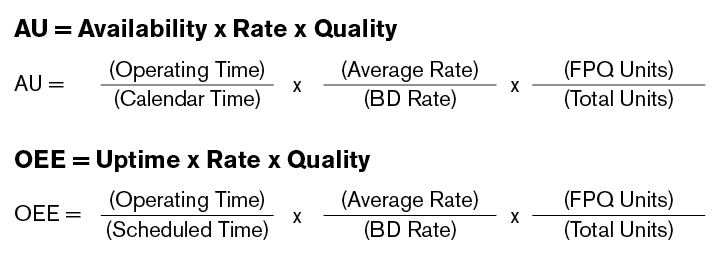What is the difference between AU and OEE?
In today’s competitive global environment, we are constantly being asked to do more with less. Now more than ever, companies are asking their employees to become more productive, more efficient…more “lean”. Strategic planning, value stream mapping, reliability engineering, loss elimination – these phrases have become popular from the board room to the shop floor. But where does their value really lie? How do we make decisions that uncover value, eliminate loss, and allow for proper strategic planning for the future? The answer lies not in the decisions we make, but in the data which we use to make those decisions. Good, strong data is key to making good, strong decisions. We are all familiar with the axiom garbage in, garbage out. So, what kind of data should we use? What metrics give us the best snapshot of our current levels of performance? If you read the title of this article, chances are you’re ready to guess.
Asset Utilization and OEE are key performance-based metrics that – when calculated and communicated properly – allow for effective facility management and provide sound backing for potentially difficult business decisions to be made. Much confusion, however, lies in their definition and understanding when and where to use them.
Asset Utilization is defined as: AVAILABILITY x RATE x QUALITY
Overall Equipment Effectiveness (OEE) is defined as: UPTIME x RATE x QUALITY
As we can see, AU and OEE are similar – both calculations for RATE and QUALITY are the same, and are defined as follows:
Where average rate is the speed or efficiency of the system under analysis over a given time period. Best demonstrated or design rate is determined by the nameplate capacity of the system or the best demonstrated rate recorded. I prefer to use the best demonstrated rate, as empirical data is a better model of the system in question. A 100% RATE calculation would signal that the system is operating consistently at its maximum demonstrated speed.
Where first pass units is defined as the good units produced over a certain time period that meet customer specifications. These “quality” units are compared to the total units produced – which include those that do not meet customer specifications. A 100% QUALITY calculation would signify no scrap or rework in the process.
Based on the above formulas, we can easily see that the difference between OEE and AU lies in how one compares availability and uptime. So what is the difference? AVAILABLITY and UPTIME are defined as follows:
Where operating time is defined as the amount of time that the system is actually operating. Calendar time is based on the 24/7/365 schedule as we know it. Scheduled time is defined as the amount of time the system under analysis was planned or scheduled to operate. So, if I operate my system for six hours on one eight hour shift on a given day, my UPTIME is 6/8 or 75%, while my AVAILABILITY is 6/24 or 25%. What a difference! Typically, OEE is used to understand how well systems or assets perform based on current business demands and production schedules. AU allows for a better understanding of how well that system or asset is currently utilized and allows insight for future business planning by calculating what type of production could be achieved.
In some industries (petroleum, specialty chemical, etc.), scheduled time is equal to calendar time and in that case, AVAILABILTY = UPTIME, and OEE and AU are equal. This scenario is similar to how a square is a rectangle but a rectangle isn’t a square. It’s easy to understand once you’ve got it, but confusing the first couple of times you hear it.
It is important now to take a few moments and discuss terminology. My background in six sigma differentiated between AVAILABILITY and UPTIME for AU and OEE, respectively – as defined above. Lean terminology defines OEE as the product of AVAILAIBILITY x RATE x QUALITY, with AVAILAILBITY defined in the same way UPTIME is defined, above. So which is correct? Truth is, it doesn’t matter. As Shakespeare said, “What's in a name? that which we call a rose, By any other name would smell as sweet.” What IS important is to clearly define what you and your organization are trying to capture, agree on common terminology to allow for clear, concise discussion, and determine the best way to capture the needed data. As always, the devil is in the details. When setting up data capture systems to determine RATE and QUALITY and UPTIME/AVAILABILITY calculations, take care to ensure consistent measurement and data validity.
Summary:
AU and OEE are defined as…
References: Vorne Industries. The Fast Guide to OEE.
© Life Cycle Engineering

For More Information
843.744.7110 | info@LCE.com

